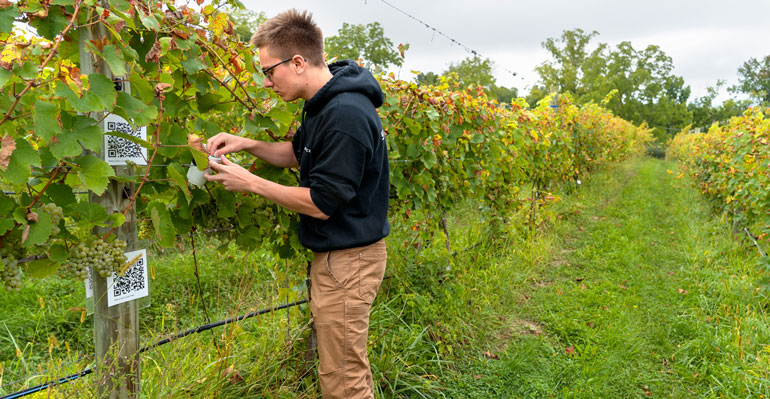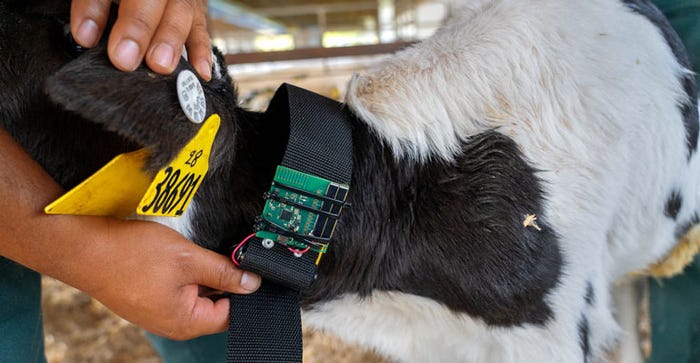November 15, 2019

The seeds of space exploration are being planted in several New York state vineyards as well as on a dairy farm.
Hunter Adams, a Ph.D. student, is deploying thumbnail-sized satellites to monitor environmental conditions in vineyards as well as cow behavior on dairies.
“Earth is a really convenient planet to do these proof-of-concept studies,” Adams says. It’s a case study for a planetary science mission where the planet happens to be Earth.
“Each satellite is its own little autonomous device, but you can think of them as a big distributed sensor when dozens or hundreds of them are deployed simultaneously. Anytime you’re trying to study something that changes significantly over space and over time, that’s the kind of sensor you want to use.”
The satellites, which Adams has dubbed Monarchs, are a customized version of the ChipSat technology that was first developed in the lab of Mason Peck, a professor of mechanical and aerospace engineering and former NASA chief technologist.
Tracking vineyard conditions
Adams modified the initial ChipSat design to survey agricultural conditions, including temperature, humidity and ambient light.
In July, he deployed 20 Monarchs at the Anthony Road Vineyard in Penn Yan, N.Y., and a month later he installed another 20 at the Cornell University teaching vineyard in Lansing, N.Y.
Each device was placed in a small plastic foam cup so its temperature readings wouldn’t be thrown off by sustained exposure to direct sunlight. They were each attached to a vine. The Monarchs, via a small radio attached to each device, transmitted data every 20 minutes to a small, off-the-shelf single-board computer located on-site.
Vineyard and orchard managers typically rely on weather stations to get conditions in order to schedule things such as fungicide and pesticide sprays. But weather conditions can vary even inside a single vineyard or orchard.
 HI-TECH MONITORS: Each Monarch at the Cornell teaching vineyard is encased in a small plastic foam cup, so its temperature readings won’t be affected by sustained exposure to direct sunlight.
HI-TECH MONITORS: Each Monarch at the Cornell teaching vineyard is encased in a small plastic foam cup, so its temperature readings won’t be affected by sustained exposure to direct sunlight.

“This is particularly true overnight, when the leaf canopies trap cool, humid air in their interior. If you’re not in there measuring that cool, humid air, you end up with a different temperature reading,” Adams says. “I’ve been able to show a difference of up to 6 degrees Fahrenheit inside the canopy versus at the weather station. It’s not huge, but over enough days that can affect a maintenance decision.”
Monitoring cow health
Vineyards aren’t the only places the Monarchs have been deployed. Adams is working with Francisco Leal-Yepes, clinical instructor of ambulatory and production medicine in the College of Veterinary Medicine, to study how air quality and physical activity correlates to respiratory problems in dairy cows.
Adams outfitted 10 newborn calves at Sunnyside Farm in Scipio Center, N.Y., with dog collars affixed with the Monarchs.
By tracking the calves’ high-frequency movements, the researchers can map the daily habits of specific animals — where they go, how often they eat — which could help dairy farmers identify changes in a calf’s daily routine that might signal it is sick.
“The earlier you can tell a dairy farmer that a calf isn’t feeling well, the better,” he says.
 MONITORING COW HEALTH: Ten calves at Sunnyside Farm in Scipio Center are being monitored using Monarch-equipped collars to study how air quality and physical activity correlate to respiratory problems.
MONITORING COW HEALTH: Ten calves at Sunnyside Farm in Scipio Center are being monitored using Monarch-equipped collars to study how air quality and physical activity correlate to respiratory problems.

Thanks to advancements in cellphone and gaming technology, the device’s surface-mounted sensors and processors can be made quite cheaply. Produced in bulk quantities of several thousand or more, Adams estimates they could cost roughly $50 apiece.
Getting farmer feedback
Even though he is from Lebanon County, Pa., an historically agricultural county, Adams didn’t grow up on a farm, although his grandparents grew tobacco and his cousins raise livestock.
In order to get a clearer sense of the potential agricultural uses for the small satellites, he visited 130 farming operations across the U.S. and in New Zealand’s Hawke’s Bay area over eight months as part of Cornell Engineering’s Commercialization Fellowship program.
It was through this process that he identified vineyards and orchards as being the most immediate beneficiaries of his technology.
“The most important aspect for a commercial application of these things is actionability,” he says. “So if I tell a vineyard manager that part of his or her vineyard is getting too cold, there’s actually something they can do about that in a lot of cases.”
While drones and other advances in digital agriculture have helped growers modernize their practices, many of those tools rely on remote sensing. Using a distributed swarm of ChipSats to capture an up-close view of individual fruit has the potential to “change the paradigm,” Peck says, and that could have implications for any number of crops throughout New York state and beyond.
“I’m confident that if we use these ChipSats as sensors in an agricultural environment, we’re going to end up saving money, improving the yield for crops and probably lowering the cost of all the things that we farm in this state,” Peck says. “Grapes are just the beginning. We could find different applications, particularly for more artisanal crops or crops that require more nurturing. That can only be good for the agricultural economy in the state, and much more broadly, for New York products being able to be sold across the nation or around the world.”
Adams says that his goal is to eventually start a business around the Monarchs.
Nutt is a writer for the Cornell Chronicle.
Source: Cornell University, which is solely responsible for the information provided and is wholly owned by the source. Informa Business Media and all its subsidiaries are not responsible for any of the content contained in this information asset.
You May Also Like




